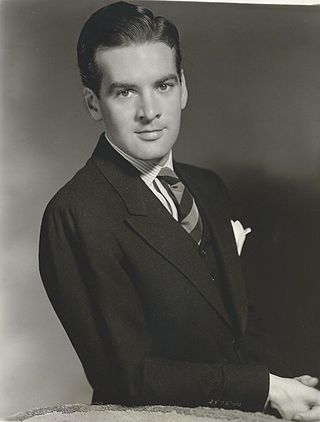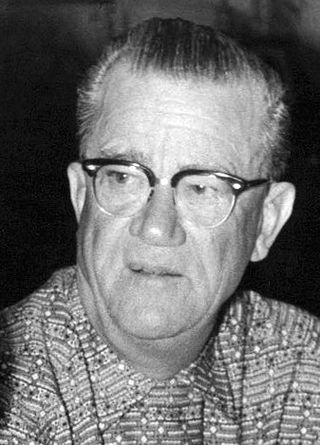Related Research Articles
Texaco Star Theater is an American comedy-variety show, broadcast on radio from 1938 to 1949 and telecast from 1948 to 1956. It was one of the first successful examples of American television broadcasting, remembered as the show that gave Milton Berle the nickname "Mr. Television".

Jack Harold Paar was an American talk show host, writer, radio and television comedian, and film actor. He was the second host of The Tonight Show from 1957 to 1962. Time magazine's obituary of Paar reported wryly, "His fans would remember him as the fellow who split talk show history into two eras: Before Paar and Below Paar."

Sylvester Laflin "Pat" Weaver Jr. was an American broadcasting executive who was president of NBC between 1953 and 1955. He has been credited with reshaping commercial broadcasting's format and philosophy as radio gave way to television as America's dominant home entertainment. His daughter is actress Sigourney Weaver.

Dinah Shore was an American singer, actress, and television personality, and the chart-topping female vocalist of the 1940s. She rose to prominence as a recording artist during the Big Band era. She achieved even greater success a decade later in television, mainly as the host of a series of variety programs for the Chevrolet automobile company.

Arthur Godfrey's Talent Scouts was an American radio and television variety show which ran on CBS from 1946 until 1958. Sponsored by Lipton Tea, it starred Arthur Godfrey, who was also hosting Arthur Godfrey and His Friends at the same time.

The Red Skelton Show is an American television comedy/variety show that aired from 1951 to 1971. In the decade prior to hosting the show, Richard "Red" Skelton had a successful career as a radio and motion pictures star. Although his television series is largely associated with CBS, where it appeared for more than sixteen years, it actually began and ended on NBC. During its run, the program received three Emmy Awards, for Skelton as best comedian and the program as best comedy show during its initial season, and an award for comedy writing in 1961. In 1959 Skelton also received a Golden Globe for Best TV Show.

The Colgate Comedy Hour is an American comedy-musical variety series that aired live on the NBC network from 1950 to 1955. The show featured many notable comedians and entertainers of the era as guest stars. Many of the scripts of the series are archived at the UCLA Library in their Special Collections.

Ray Heatherton was an American singer, Broadway musical theatre performer, and a New York City television personality in the early days of the medium.

The National Broadcasting Company's NBC Radio Network was an American commercial radio network which was in continuous operation from 1926 through 1999. Along with the NBC Blue Network, it was one of the first two nationwide networks established in the United States. Its major competitors were the Columbia Broadcasting System (CBS), founded in 1927, and the Mutual Broadcasting System, founded in 1934. In 1942, NBC was required to divest one of its national networks, so it sold NBC Blue, which was soon renamed the American Broadcasting Company (ABC). After this separation, the Red Network continued as the NBC Radio Network.

Ford Star Jubilee is an American anthology series that originally aired monthly on Saturday nights on CBS at 9:30 P.M., E.S.T. from September 24, 1955, to November 3, 1956,. The series was approximately 90 minutes long, broadcast in black-and-white and color, and was typically telecast live. Ford Star Jubilee was sponsored by the Ford Motor Company.

Ford Theatre, spelled Ford Theater for the original radio version and known, in full, as The Ford Television Theatre for the TV version, is a radio and television anthology series broadcast in the United States in the 1940s and 1950s. At various times the television series appeared on all three major television networks, while the radio version was broadcast on two separate networks and on two separate coasts. Ford Theatre was named for its sponsor, the Ford Motor Company, which had an earlier success with its concert music series, The Ford Sunday Evening Hour (1934–42).

The Fleischmann's Yeast Hour was a pioneering musical variety radio program broadcast on NBC from 1929 to 1936, when it became The Royal Gelatin Hour, continuing until 1939. This program was sponsored by Fleischmann’s Yeast, a popular brand of yeast.
The Milt Grant Show was an American teen dance television show hosted by Milton "Milt" Grant (1923–2007). It aired on WTTG, an independent station in Washington, D.C., from 1956 until 1961. Similar in tone to Philadelphia station WFIL-TV's Bandstand, the program was not only the market's highest-rated television program throughout much of its run but preceded a lifelong career in television station management and ownership for Grant. The program was regarded as a cultural icon of late 1950s and early 1960s Washington.

Star Time is an American variety series that aired on the DuMont Television Network from September 5, 1950, to February 27, 1951, and starred singer-actress Frances Langford. It was broadcast from 10 to 11 p.m. on Tuesdays.

Ralph David Foster was an American broadcasting executive and philanthropist who created the framework for Springfield, Missouri, to challenge Nashville, Tennessee, as the nation's country music capital during the 1950s. His KWTO was a stepping-stone for many top country artists; and with his music businesses, led to creation of Ozark Jubilee, the first U.S. network television program to feature country's top stars.
Perry Como was an American singer, radio and television performer whose career covered more than fifty years. He is probably best known for his television shows and specials over a period of almost thirty years. Como came to television in 1948 when his radio show was selected by NBC for experimental television broadcasts. His television programs were seen in more than a dozen countries, making Como a familiar presence outside of the United States and Canada.
Stop the Music is a prime time radio game show that aired on ABC Radio on Sundays, from March 21, 1948 to August 10, 1952. Stop the Music crossed over to ABC television on Thursdays, beginning on May 5, 1949 through April 24, 1952, and again for a half-hour from September 7, 1954, to June 14, 1956.
The Fred Allen Show is a long-running American radio comedy program starring comedian Fred Allen and his wife Portland Hoffa. Over the course of the program's 17-year run, it was sponsored by Linit Bath Soaps, Hellmann's, Ipana, Sal Hepatica, Texaco and Tenderleaf Tea. The program ended in 1949 under the sponsorship of the Ford Motor Company.
This Is Show Business is an American variety television program that was broadcast first on CBS and later on NBC beginning July 15, 1949, and ending September 11, 1956. It was CBS-TV's first regular series broadcast live from coast to coast. It was originally titled This Is Broadway.
The Peter Lind Hayes Show is the title of two American television shows and one American radio program. One TV show was a situation comedy broadcast in prime time on NBC in 1950-1951. The other was a daytime variety program on ABC in 1958-1959. The radio program was a weekly variety show on CBS in 1954-1955.
References
- 1 2 3 4 5 Dunning, John (May 7, 1998). On the Air: The Encyclopedia of Old-Time Radio. Oxford University Press. p. 726. ISBN 978-0-19-984045-8 . Retrieved October 21, 2023.
- 1 2 "'Woolworth Hour' Dedicated to Canadian Music". The Times. Louisiana, Shreveport. September 4, 1955. p. 32. Retrieved October 21, 2023– via Newspapers.com.
- 1 2 3 4 5 Gould, Jack (June 7, 1955). "Radio: Musicians, Live: Percy Faith Show Has Premiere on C. B. S." . The New York Times. p. 67. Retrieved October 19, 2023.
- 1 2 3 Mercer, Charles (April 26, 1957). "Woolworth Hour Stars To Celebrate 100th Consecutive Broadcast Sunday". The Kokomo Tribune. Associated Press. p. 27. Retrieved October 21, 2023– via Newspapers.com.
- 1 2 Anderson, Lilla (May 1956). "The Woolworth Hour". TV Radio Mirror. pp. 60, 83. Retrieved October 21, 2023.
- ↑ Adams, Val (June 8, 1956). "Miner to Produce New Video Series: Named to Executive Post on 'Kaiser Aluminum Hour'-- First Show on July 3" . The New York Times. p. 37. Retrieved October 20, 2023.
- ↑ "Music as Written: New York". Billboard. July 23, 1955. p. 22. Retrieved October 21, 2023.
- ↑ Sachs, Bill (May 6, 1957). "Folk Talent & Tunes". Billboard. p. 64. Retrieved October 21, 2023.
- ↑ "Radio-TV Guide". Jet. August 11, 1955. p. 66. Retrieved October 21, 2023.
- ↑ Crossland, Ken; Macfarlane, Malcolm (July 12, 2013). Late Life Jazz: The Life and Career of Rosemary Clooney. Oxford University Press. ISBN 978-0-19-933956-3 . Retrieved October 21, 2023.
- ↑ "Dolores Hawkins booked through January". Billboard. December 17, 1955. p. 42. Retrieved October 21, 2023.
- ↑ "Radio-TV Guide". Jet. August 4, 1955. p. 66. Retrieved October 21, 2023.
- ↑ "Radio-TV". Jet. November 3, 1955. p. 66. Retrieved October 21, 2023.
- ↑ "Firestone Voice Calls Miss Wyatt" . The New York Times. February 23, 1957. p. 35. Retrieved October 20, 2023.
- 1 2 3 4 "Radio Followup". Variety. August 17, 1955. p. 39. Retrieved October 21, 2023.
- 1 2 "Woolworth: Network radio's radical". Sponsor. August 6, 1956. pp. 42–43, 90–92, 94. Retrieved October 21, 2023.
- ↑ "Musical Tribute to Gershwin Set: 'Woolworth Hour' on C.B.S. Radio on Sunday Will Offer Selections and Speeches" . The New York Times. September 19, 1956. p. 74. Retrieved October 19, 2023.
- 1 2 3 Adams, Val (March 29, 1955). "Woolworth Buys Hour Radio Show: Chain Will Sponsor Sunday Musical Series From 1 to 2 P.M. on C.B.S. Network" . The New York Times. p. 38. Retrieved October 19, 2023.
- ↑ "Multi-Million Baby" (PDF). Broadcasting. April 11, 1955. p. 126. Retrieved October 21, 2023.
- 1 2 Freeman, William M. (October 14, 1956). "News of the Advertising and Marketing Fields: Success Story Switch Smart Boss Marries Account Executive" . The New York Times. p. F 10. Retrieved October 20, 2023.
- ↑ Adams, Val (May 17, 1955). "Screen Directors Will Do TV Series" . The New York Times. p. 38. Retrieved October 20, 2023.
- ↑ Cox, Jim (January 10, 2014). Musicmakers of Network Radio: 24 Entertainers, 1926-1962. McFarland. p. 127. ISBN 978-0-7864-8962-6 . Retrieved October 21, 2023.
- 1 2 3 "The Woolworth Hour". Variety. June 8, 1955. p. 40. Retrieved October 21, 2023.
- ↑ "2nd Movie Music Awards Named; Sinatra, Day Tops". Down Beat. February 22, 1956. p. 7. Retrieved October 21, 2023.